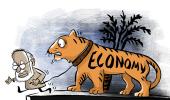The number of equity schemes rose to 562 from 519 two years ago.
Equity NFOs, in fact, have mopped up more than Rs 16,000 crore since 2018 - 2.7 times the Rs 5,948 crore collected in the preceding three calendar years.
Illustration: Uttam Ghosh/Rediff.com

In a room full of distributors, Motilal Oswal AMC’s (MOAMC’s) sales and distribution head, Akhil Chaturvedi, hard-sells the asset manager’s large- and mid-cap schemes, a new fund offering (NFO).
Chaturvedi tries to convince the group of 100-odd distributors that the NFO can help create excitement among investors, especially those sitting on the sidelines, and get them to invest.
Distributors NJ India Invest, Bajaj Capital, and Karvy are aiding the book building, he says, and Motilal Oswal’s promoters will invest a sizeable chunk of proprietary money.
“We are doing this NFO with a lot of passion and conviction,” Chaturvedi says.
MOAMC is not alone. About 24 fund houses have hit the market with 43 NFOs this year, garnering a little over Rs 7,500 crore.
This was at a time when the Sensex rose 4.1 per cent.
Investors should have found NFOs unpalatable, what with sustained market volatility, a steep erosion in the value of mid- and small-cap names, and the underperformance of existing funds.
However, the collection figures indicate otherwise.
Equity NFOs, in fact, have mopped up more than Rs 16,000 crore since 2018 - 2.7 times the Rs 5,948 crore collected in the preceding three calendar years.
“NFOs are still the number one tool for gathering assets,” says Swarup Mohanty, CEO of Mirae Asset AMC, whose two recent launches - a mid-cap and a focused fund - have collected more than Rs 1,500 crore.
“When times are tough, pitching a new story can spur investor interest.
"The psychology of buying into a fund with a 10-rupee net asset value (NAV), even if a marketing gimmick, can also be a draw,” he adds.
The slew of launches has also been dictated by the Securities and Exchange Board of India’s (Sebi’s) one-scheme-per-category diktat, in play from last year.
Fund houses, especially the medium and smaller ones, are using these launches to complete their product portfolio.
Sebi has broadly classified equity schemes under 10 categories.
There is no restriction on the number of index funds, exchange-traded funds, fund of funds, and sector/thematic funds that can be launched.
“Unlike earlier, most fund houses are launching NFOs to fill the gap in their product portfolio, not to garner revenues.
"While distributors benefit from a slightly higher trail commission, incentives are low because there is no upfront payout,” says Chaturvedi.
For instance, a few years ago, upfront commissions for selling closed-ended schemes could go as high as 5-6 per cent.
This year, three mid-cap, four small-cap, eight large-cap, and nine multi-cap schemes have been launched.
A dozen are index- or exchange-traded funds (ETFs), which include sectoral and thematic schemes.
The number of equity schemes rose to 562 from 519 two years ago.
“Index funds and ETFs are probably being launched to provide an alternative to investors in large-cap funds, especially considering the latter’s underperformance in the recent past,” says Dhaval Kapadia, director (portfolio specialist), Morningstar Investment Advisers India.
Chaturvedi says new funds come with no baggage (in terms of returns) and are more agile as the corpus managed is smaller.
Ironically, the lack of a track record is proving to be a selling-point, considering the underperformance of a large number of existing diversified equity schemes.
Financial advisors do not advocate for NFOs as they do not come with a track record.
It is better to avoid unless it is a diversified offering.
That NFOs are cheaper than existing funds is a misconception, say experts.
Say, an existing fund has a NAV of Rs 100. One can buy 10 units of the fund for Rs 1,000.
Investing in the NFO at Rs 10 would get you 100 units.
If both schemes grow 10 per cent over the next year, their investment value would rise to Rs 1,100.
Buying a Rs 10 fund, in other words, will not help you realise higher gains.












 © 2025
© 2025